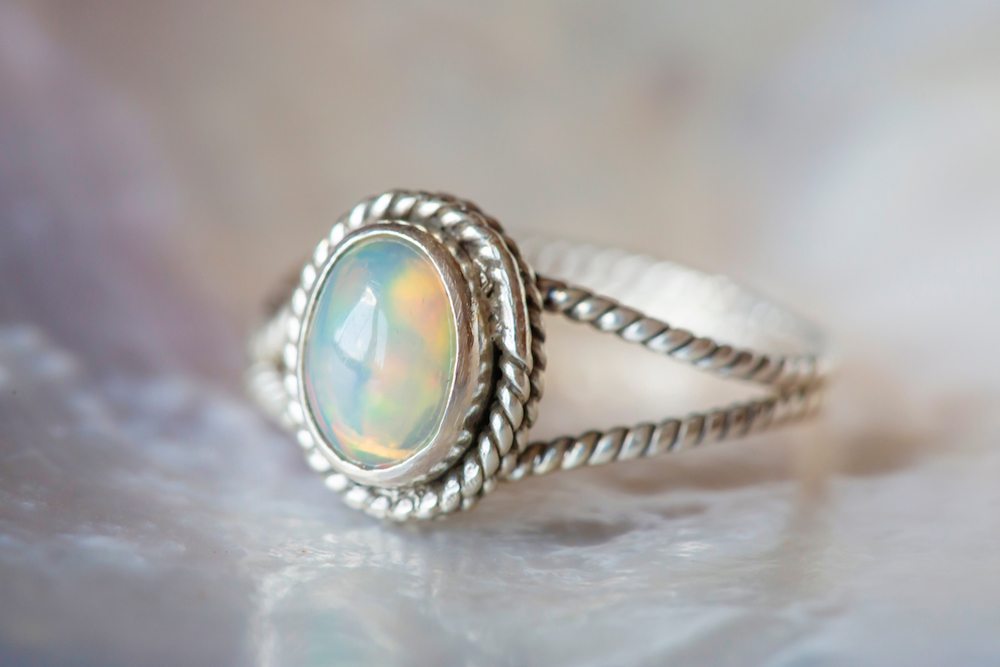The Romans believed opals were the most precious and powerful gem because it contained the colors of all the others. The Bedouins thought the fire of an opal was lightening that fell from the sky. One look at a quality opal and you can see why it’s been prized for centuries.
What is an opal?
Opals were first discovered in Australia in the 1870s and the most valuable opals come from Queensland and New South Wales. Australia produces more than 90 percent of the opals in the world but they are also found in Brazil, the Czech Republic, Indonesia and Ethiopia.
Opals get their fiery color from the silica that deposits in rock crevices. As rain is soaked deep into underground rock in Australia’s semi-desert outback, it carries dissolved silica with it. As the water evaporates, the silica deposits form tiny spheres in a variety of patterns and colors. It’s for this reason that no two opals are alike.
Opals are measured in carat weight and by the actual size of the stone. It’s a softer gem, with a 6.0-6.5 rating on the hardness scale.
What should I look for when I buy an opal?
Most people are familiar with the C’s of a diamond – color, clarity, cut and carat weight. Opals also have similar qualities you should look, all based on color. These include body tone, color, type of opal, body tone, brilliance, pattern and probably the most familiar, its play-of-color.
Body Tone
The body tone of an opal is its basic color. Ignoring the streaks of color within the opal, the gem’s body tone is assessed while holding the stone face up. It can range from black (rare, found only in Lightening Ridge, Australia) to transparent. Opals with a darker body tone are generally more valuable because they display the colors within them more vibrantly.
Play-of-Color
An opal’s play-of-color is a result of the different colors of silica present while the stone is formed. All silica is microscopic but the larger ones are red, a more scarce color in nature than blue or green.
This play-of-color comes from the reflection of light across the minute, closely-packed silica spheres. The arrangements and sizes of the silica create the different colors. All opals have color within them but it’s the variety and strength of the colors that can make them more or less valuable. A dull stone with many colors will be less valuable than an opal with single, vibrant color.
The variety and vibrancy of an opal’s color is important but there are other things to consider when buying an opal.
Pattern
Opal patterns aren’t exactly repeating structures. Instead, they’re classified by their shape, size and direction. There is a very rare geometric pattern called the Harlequin. In this pattern, large sections of color are segmented in roughly the same size and shape, like a checkerboard.
Every opal’s silica spheres that give it its color also forms a pattern unique to that opal. The names of these patterns can be very creative and vary from jeweler to jeweler, such as bamboo, cathedral or dragon skin. But regardless of the names, there are some color patterns that are preferable than others. Some of the excellent patterns include:
- large sections of color with straight edges in a random pattern, as you’d find in flagstones
- thin strips of overlapping colors, either random or overlapping
- narrow strips of color that are parallel
Less favorable color patterns, but still good are random patterns of color but with a good spread over the stone’s face. An opal with an undesirable pattern will have its colors indistinct or smudgy-looking.
Brilliance
Brilliance refers to how vivid and clear the colors are within the stone. The brighter and more clear the colors, the more valuable the stone. An opal is classified on a scale of dull to subtle to bright.
What to watch for:
Stay away from opals that have one or more cracks, no matter how small, in the gem’s face. These will make the opal worthless. Since opals are a softer stone, a crack could eventually make it break into two. Opals are natural stones so there could be sand or other minerals found in them but it’s best to avoid these opals.
How to care for an opal
Opals are a softer gem and can easily be scratched so take care when you wear it. For that same reason, you should never keep them in oil or wear them while working with chemicals. Don’t keep them stored in a vault where they’ll get dried. This could cause them to crack.
Conclusion
If your or a loved one’s birthday is in October, opal is your birthstone. It’s also the gem for the 14th wedding anniversary.
Our jewelers at Neustaedter’s can help you find the right quality opal for you or your loved one. If you already own an opal, bring it in and we’ll take a look at its settings and check the gem for cracks and wear. Have questions? Contact us, or stop by our fine jewelry showroom.

